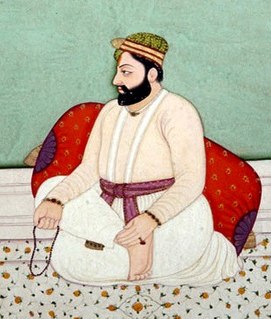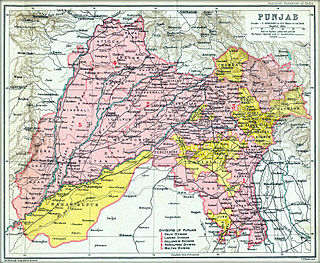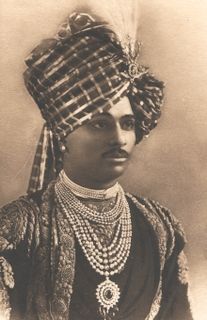
Patiala is a city in southeastern Punjab, northwestern India. It is the fourth largest city in the state and is the administrative capital of Patiala district. Patiala is located around the Qila Mubarak. It was constructed by Sidhu Jat chieftain 'Baba Ala Singh', who founded the royal dynasty of the Patiala State in 1763.

A gurdwara is a place of assembly and worship for Sikhs. People from all faiths, and those who do not profess any faith, are welcomed in Sikh gurdwaras. Each gurdwara has a Darbar Sahib where the current and everlasting guru of the Sikhs, the scripture Guru Granth Sahib, is placed on a takhat in a prominent central position. The raagis recite, sing and explain, the verses from the Guru Granth Sahib, in the presence of the congregation.
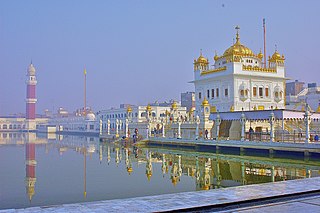
Gurdwara Sri Tarn Taran Sahib is a gurdwara established by the fifth guru, Guru Arjan Dev, in the city of Tarn Taran Sahib, Punjab, India. The site has the distinction of having the largest sarovar of all the gurdwaras. It is famous for the monthly gathering of pilgrims on the day of Amavas. It is near Harmandir Sahib, Amritsar.

Malerkotla is a city and a municipal council in Sangrur district in the Indian state of Punjab. It was the seat of the eponymous princely state during the British Raj. The state acceded unto the union of India in 1947 and was merged with other nearby princely states to create the Patiala and East Punjab States' Union (PEPSU).

Tarn Taran Sahib is a town in the Majha region of the state of Punjab, in northern India. It is the district headquarters and hosts the municipal council of Tarn Taran district. Gurdwara Sri Tarn Taran Sahib, a prominent Sikh shrine is located in the central part of the city.

Batala is the eighth largest city and muncipal coproration(since 3rd march 2019) in the state of Punjab, India in terms of population after Ludhiana, Amritsar, Jalandhar, Patiala, Bathinda, Mohali and Hoshiarpur. It is a municipal corporation in Gurdaspur District in the Majha region of the state of Punjab, India. It is located about 32 km from Gurdaspur, the headquarters of the district. It is also a Police District. Batala ranks as the most populated town of the district with 31% of the total population of district. It is the biggest industrial town in the district. It is the centre of the Majha region of Punjab.

Chamkaur Sahib is a Sub Divisional town in the district of Rupnagar in the Indian State of Punjab. It is famous for the First Battle of Chamkaur (1702) and the Second Battle of Chamkaur (1704) fought between the Mughals and Guru Gobind Singh.

Moga is a city in the Indian state of Punjab. Moga was named after Moga Singh Gill, a prominent person of the Gill community.

Balachaur is a town in Balachaur Tehsil in the Nawanshahr district of Punjab, India.

The town of Mullanpur Dakha, also known as Mandi Mullanpur, is located in the Ludhiana district in the Indian state of Punjab. It is a nagar panchayat, a settlement in transition from rural to urban. Due to the availability of transport routes to other villages, the town serves as a marketplace of grain and other goods to the surrounding area.
The Khangura is a gotra of Jatts from the Punjab region in India.

Banga is a town and Municipal council in the Shahid Bhagat Singh Nagar district of Punjab, India. Banga is also one of the sub-division (tehsil) headquarters of the district. Banga located on Phagwara-Rupnagar section of National Highway 344A. It is currently estimated to have a population of about 23,000 and is classified as a class 2 Municipality. The town also incorporates the former village of Jindowal apart from Banga town.

Bagrian is a village located in Sangrur District, in Punjab, India which has a significant place in Sikh history.

Narur, also known as Naroor and sometimes Naror, is a large village in Punjab, situated 17 km from Phagwara. The area is 183 hectares with a population of 2485.

Gurdwara Manji Sahib is located near the village of Alamgir, Ludhiana district, Punjab, India. Guru Gobind Singh, tenth guru of the Sikhs, stayed here for a short while. Upon reaching Alamgir, Guru Gobind Singh is reported to have shot an arrow into the ground; a spring appeared from that place. He was also presented with a horse here by a devoted follower.

Kiratpur also known as Kiratpur Sahib is a town in Rupnagar district, Punjab, India. The town is the location of the Gurdwara Patal Puri where Sikhs take ashes of their dead.

Manuke is a village on Guru Gobind Singh Marg (highway) in district Ludhiana, state of Punjab, India. It is one of the largest village in Jagraon block. The world-famous Gurdwara Mehdiana Sahib is situated outside the village on the west. The village is populated mostly by Sandhu families. It has two main Gurdwara's, Shivdwala, and a Masjid. One Of the Gurdwara Patshahi Dasvee was visited by Guru Gobind Singh himself. The village has built a state of the art modern funeral home.

Rara Sahib is a village near Ludhiana city in Punjab, India. This village was transformed from simple Rara to Rara Sahib due to the visit by the sixth Sikh Guru, Guru Hargobind Ji.
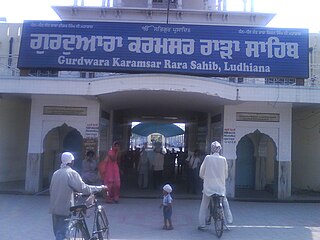
Gurdwara Karamsar Rara Sahib or Gurdwara Rara Sahib is situated at village Rara Sahib near Ludhiana. Rara Sahib is a village near Ludhiana city in Punjab, India. This village was transformed from simple Rara to Rara Sahib due to the visit by the sixth Sikh Guru, Guru Hargobind Ji.
Saidpur is a village in Sultanpur Lodhi Tehsil, Kapurthala district, Punjab, India,situated in the footsteps of Margalla Hills hardly at five minutes drive from the upscale neighbourhoods of the capital.






